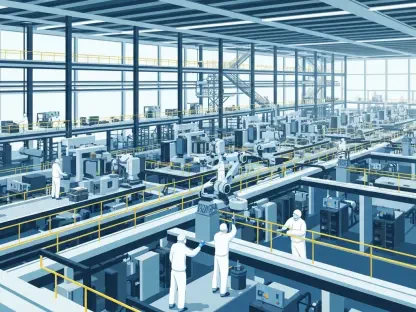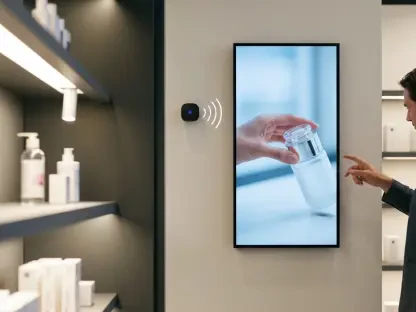The digital transformation within the architecture, engineering, and construction sectors has been marked by periodic leaps forward, often driven by technological prowess aimed at enhancing workflow efficiency and capacity for collaboration. Introducing a fresh paradigm is Arcol, a promising startup, introducing its cloud-native BIM 2.0 platform intent on revolutionizing the conceptual phase of architectural design. In a domain where established incumbents predominantly shape the design landscape, Arcol seeks to carve out its niche by focusing on real-time collaboration and dynamic presentation tools, a move set to redefine traditional workflows and integrate a variety of functionalities within a single browser-based environment. The stage is set for Arcol to challenge market norms and catalyze a new era in architectural design with innovative, all-encompassing tooling and platform capabilities.
The Conceptual Focus: A New Approach
Arcol’s primary goal is to target the initial stages of architectural design, offering a suite of tools tailored to facilitate sketch-based modeling in conjunction with real-time collaboration capabilities. It addresses gaps left by traditional software by providing functionalities that lack complexity while being effective for conceptual development. This focus enables architects and designers to iterate rapidly and share ideas synchronously without the restrictions imposed by more traditional BIM platforms. Arcol adopts a web-based approach, removing the dependency on cumbersome software download and installation processes, thus ensuring seamless access and facilitating inter-team collaboration across geographical barriers.
The platform’s concentration on the conceptual phase naturally aligns with the aspirations of emerging designers eager to experiment and visualize their designs promptly. By eliminating technological bottlenecks, Arcol fosters a creative environment conducive to innovation while bridging the collaboration gap often faced in architectural settings. Moreover, its intuitive user interface and gentle learning curve distinguish Arcol from more complex solutions, providing a low-barrier entry for users of varying expertise levels, thus democratizing access to advanced design processes.
User Experience and Collaborative Environment
Creating an inviting atmosphere through its straightforward user interface design, Arcol prioritizes accessibility and ease of use. Unlike traditional design software that can often overwhelm new users with complexity, Arcol ensures its platform can be navigated intuitively, maximizing productivity while minimizing the learning curve. This design philosophy not only makes innovative design techniques more approachable but also engages users seeking streamlined experiences without sacrificing functionality. Furthermore, in an era defined by digital collaboration, Arcol embraces technology to enable multi-user environments where stakeholders can partake simultaneously in design endeavors.
Arcol introduces a centralized “single version of truth” model, ensuring that data remains consistent and accessible to all collaborators. This real-time data synchronization eliminates the outdated tradition of revision management systems where different parties may inadvertently work on obsolete versions, leading to inefficiencies. Embedding collaboration at the core of its architecture, Arcol fosters transparency and cultivates a unified team spirit as designers, engineers, and project managers interact seamlessly, engaging each other in dynamic, fluid discussions.
Innovative Presentation Tools
Foregoing traditional static exports such as PDFs, Arcol unveils ‘Boards’—dynamic presentation mediums that automatically update in sync with changes made to models. This innovation not only streamlines presentation processes but also allows for real-time feedback and enhanced visibility across projects, enabling stakeholders to visualize every minute design modification instantaneously. In doing so, Arcol essentially replaces conventional documentation methodologies with high-efficiency digital frameworks that promise richer engagement.
Furthermore, as Arcol integrates design and presentation tools comprehensively, it ensures deepening collaboration where contributions can be made directly within the platform. This holistic approach positions Arcol not only as a design instrument but as a potential enabler of collaborative ideation, bridging the gap between conception and presentation. By fostering environments where synchronous feedback becomes routine, Arcol changes the narrative around architectural presentations, transforming them into interactive platforms ripe for discussion, critique, and improvement.
Market Positioning and Competitive Edge
In a competitive environment dominated by giants like Autodesk’s Revit, Arcol endeavors to offer innovative solutions by integrating functionalities from various established software into a singular package, narrating a fiscal and efficiency story appealing to modern practitioners. By focusing on its strengths—real-time collaboration features, intuitive user experience, and dynamic presentation tools—Arcol finds opportunities to establish itself in areas preceding detailed design phases, allowing a smoother transition into more intricate modeling environments while being a catalyst for creativity.
Rooted in deep industry insights backed by strategic seed funding, Arcol’s execution strategy sees collaboration with industry veterans as a linchpin to its development. This positions Arcol uniquely within the AEC sector, challenging entrenched systems and potential rivals. Given its commitment to evolving beyond conceptual design towards more advanced modeling capabilities, Arcol promises substantial future advancement, anticipating integration with sophisticated tools like Rhino and Grasshopper, broadening its appeal and application in architectural workflows.
A Potential Game-Changer
Arcol effectively disrupts traditional workflow paradigms, injecting a new wave of enthusiasm in architectural design practices by streamlining conceptual processes and integrating collaboration tools directly into the design cycle. The inherent cost savings and efficiency improvements touted by Arcol’s unique web-based model may redefine how architects and designers collectively think about design, collaboration, and presentation. As technological advancements continue to shift perceptions of architectural practices, Arcol’s ability to wield these changes intelligently shapes its standing as a significant game-changer in the industry.
Strategically maneuvering through its origin and evolution, Arcol aligns itself to innovate and push the boundaries of architectural design. The platform’s emphasis on real-time collaboration and simplified processes is harmonized with an understanding of designer needs, making Arcol a promising contender in facilitating early-stage architectural endeavors. While navigating evolving dynamics and user requirements within the architectural landscape, Arcol’s synthesis of collaborative technologies showcases its potential to assist teams in transforming architectural concepts into groundbreaking realities.
Emerging Horizons for BIM 2.0
Positioned firmly within the BIM 2.0 framework, Arcol offers the integrated capabilities essential for crafting a design ecosystem where iterative, collaborative efforts lead the way. As architects grapple with time constraints and creative pressures, Arcol’s functionality caters to the necessity of rapid ideation alongside real-time modification and communication. These actions create a connective tissue where design portfolios become continuously evolving collaborative canvases, enhancing stakeholder engagement while fostering innovation.
Arcol’s foresight towards future integration with advanced modeling practices sets the stage for expansion into detailed phases, promising remarkable growth in functionality and application as efforts to develop expansive design processes continue. Poised to challenge traditional design norms head-on, Arcol’s platform—built on adaptability, accessibility, and collaboration—becomes a dynamic partner within architectural projects, inviting teams to not only imagine but reimagine, synchronously, what it means to design structures and spaces in an ever-evolving digital era.
Conclusion: Transforming Architectural Practices
Arcol’s initiative harmonized a compelling vision with strategic industry engagement, illuminating possibilities in the digital transformation of design workflows. By embedding collaboration and presentation tools within its architecture, Arcol created a platform destined to challenge conventional practices, offering enhanced capabilities tailored to the initial stages of architectural design. Set on a trajectory meant to expand into more advanced modeling processes, Arcol emerges as a formidable contender envisioned to reshape the architectural discourse.
In retrospect, Arcol-minded efforts culminated in strategic opportunities ushering new paradigms of creativity, connectivity, and collaboration, promising to redefine interaction not only within design teams but across broader architectural landscapes. Innovating beyond established market practices, Arcol carved a niche emphasizing efficiency and intuitiveness, transforming workflows within an ever-adaptive web-based environment. As the industry pursued pathways towards democratized access to advanced tools, Arcol reshaped boundaries and opened the doors for architects and designers to explore, imagine, and converse across the digital divide, propelling architectural practices towards new horizons.









